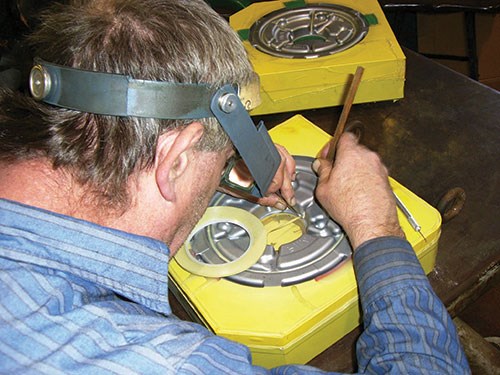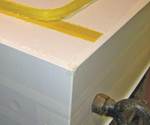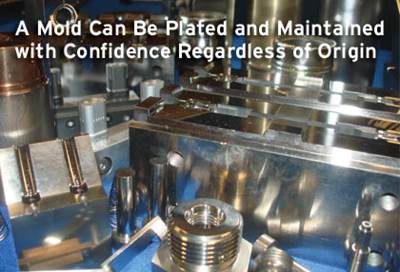Plating and Maintaining Textured Surfaces
Communication with your texturing and plating sources is key to properly maintaining the mold surface.
One of the most common questions moldmakers ask when looking for plating services on textured molds is whether or not the plating will fill in or alter the surface in any way.
The answer is no, but that concern may stem from plating processes that were commonly followed years ago. For example, bumpers for cars used to be stamped from metal and then copper plated to eliminate or cover over any imperfections. The copper coating would fill in and level the stamped metal, and then the bumpers would be decorative chrome plated (not industrial hard chrome). Today, car bumpers are no longer chrome plated, they are molded in plastic, and the mold itself may need coatings to protect it from wear.
Today’s plating coatings mimic the shape and texture of a mold, so the peaks and valleys of the texture will not be affected. For example, when you add 0.0002 inch of nickel or chrome to a mold, that exact amount will be added to both the peaks and the valleys.
Achieving Texture
Applying texture to molds has gone from being considered a “black art” to a process that requires very high technical expertise, so a plating shop should send any new mold that needs texturing to a reputable texturing house before plating.
Some texturing companies use an acid etch process, and areas of the mold that do not need texture are protected using masking, much like in the actual plating process. Submerging the mold in the acidic solution opens the pores of the unmasked metal. The texture itself is created when an artwork film of the grain is photographed onto the mold.
Once the basic texture is created using film, a D-1 surface finish (the glossiest classification) is applied with a media blast of small, round glass pellets. These pellets clean the mold surface upon contact and provide the appropriate gloss level specified by the customer using SPE/SPI standards. If the customer requires less gloss, a duller D-2 finish, which uses aluminum oxide instead of glass bead, might be applied. A D-3 finish is even duller and not used as often. Now the mold is ready for plating and can be sent back to the plating vendor where the texture will be properly maintained.
An example we encountered involved an OEM that was molding a part with a very dull finish—somewhere between a D-2 and D-3. The OEM originally specified a very light mold coating of 0.00005 to 0.0001 inch because it was concerned that the plating would fill in the texture. The resulting parts made from this mold looked awful, and the molds had to be stripped to return them to the original finish. Double the original plating thickness was then applied to the molds, and the resulting parts came out perfect.
Maintaining Texture
Over a period of time, plastic moving through a mold can alter the mold’s texture or finish, making it too shiny or too dull. The gloss level should be maintained to a specified tolerance, and the plating company should work with a texture house to maintain the desired gloss and finish.
If a textured mold is sent to a mold shop for maintenance and is already plated, the plating most likely will need to be stripped and the texture evaluated. If necessary, it may be sent on to a texture house for the texture and gloss to be reestablished or at least for a gloss adjustment. This process helps ensure that the molded components consistently match others in the same assembly. After required textures and gloss levels are re-established, the mold is ready to be plated again.
The dashboard of an automobile is an example of an assembly of molded components of varying textures. The gloss levels of the components must meet manufacturing specifications set by the OEM. Many different components make up a single dashboard, and attention must be paid to maintaining both the texture and gloss level of each individual part.
Releasing and Protecting
Release factors associated with textured surfaces can sometimes raise cycle times. Nickel-PTFE and nickel-boron-nitride coatings often are used on molds for better release and faster cycle times, as well as for lubricity and protection. Spray release products may not be appropriate when manufacturing a detailed part when over-molding because they can leave a deposit of residue, but a release coating can easily solve that issue.
For maximum protection of textured molding surfaces, diamond-chrome or chrome coatings are recommended, because they also will protect the integrity and finish of the molded parts, especially if they are to be painted or plated after molding, which occurs often in the automotive industry. In fact, we advise early consultation with the plater if the mold will need an even deposit of either of these coatings, because they require a detailed and time-intensive anode construction process. Anode construction may be required prior to mold texturing to avoid scratching or other damage from the anode.
Individual parts with different finishes and textures can be even more complicated. When a diamond-polished surface is adjacent to a textured surface, steps must be taken to protect each surface during each process. The texture house will often send items back to the polishing and plating vendor for an additional light polish.
If a textured mold is producing parts from PVC, which emits a chloride gas, it should be plated with nickel, unless the mold is built from stainless steel. This also applies to molds built from aluminum.
Summary
Coordination between the texture house, the plating house, the molder and moldmaker is essential to ensure the proper texture maintenance and the proper gloss level of a mold before plating.
Related Content
What is Scientific Maintenance? Part 2
Part two of this three-part series explains specific data that toolrooms must collect, analyze and use to truly advance to a scientific maintenance culture where you can measure real data and drive decisions.
Read MoreHands-on Workshop Teaches Mold Maintenance Process
Intensive workshop teaches the process of mold maintenance to help put an end to the firefighting culture of many toolrooms.
Read MoreMaking Quick and Easy Kaizen Work for Your Shop
Within each person is unlimited creative potential to improve shop operations.
Read MoreICYMI: MMT Chats: True Leadership Leads to Mentoring, Part 1
This trio from TK Mold and Engineering in Romeo, Michigan, joins me to discuss the role of leadership and culture in mentorship. This episode is brought to you by ISCAR with New Ideas for Machining Intelligently.
Read MoreRead Next
It Is What It Is, But What Is It?
With the right tools and experience, a mold can be plated and maintained with confidence no matter where it originated or what materials were used to build it.
Read MoreTexturing Molds for Thermoplastics: Factors for Success
Factors to consider when selecting a texture or grain for a thermoplastic mold or die.
Read MoreHow to Use Continuing Education to Remain Competitive in Moldmaking
Continued training helps moldmakers make tooling decisions and properly use the latest cutting tool to efficiently machine high-quality molds.
Read More_970x90 1.png;maxWidth=970;quality=90)









_300x250 4.png;maxWidth=300;quality=90)
.png;maxWidth=300;quality=90)




.jpg;maxWidth=300;quality=90)











